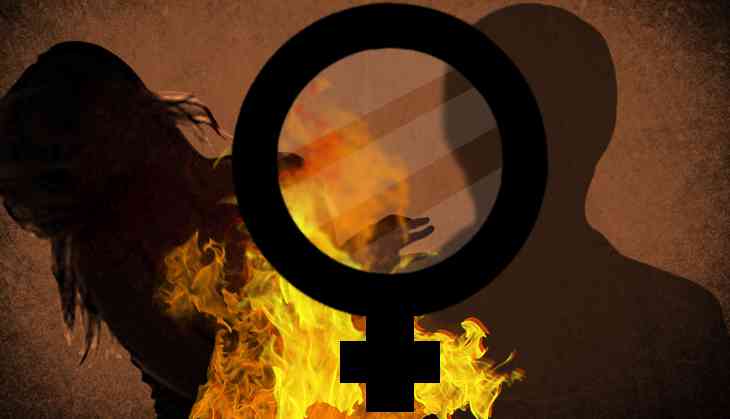
When Annu Devi gave birth to a baby girl, it should have been cause for celebration. Instead, it was to be the start of the end for Devi.
Her husband and his family, upset that the baby wasn't male, began harassing her. On 30 January, 2014, as Devi was breastfeeding her daughter Kajal, her husband doused the two in kerosene and set them ablaze. While the baby died then and there, Devi was found by locals, barely clinging to life in the courtyard where she was burned. She died before she could be taken to a hospital.
To make the death seem accidental and self-inflicted, Devi had been asked to boil paddy on the fireplace just prior to the crime. And, while her case may seem uniquely heinous, Devi's story unfolds almost daily across the length and breadth of the country.
On 23 March, 2017, Chennai-based International Foundation for Crime Prevention and Victim Care (PCVC) has revealed alarming data about one of the most overlooked, and yet common, reasons for female deaths in India. According to PCVC, an estimated 91,000 women die of burn injuries in India every year.
According to PCVC, "Indian women between the ages of 15 and 50 are the most prone to fire-related deaths compared to women of any other country." This finding is based on data from the Institute of Health Metrics & Evaluation.
PCVC's research has shown that of these 91,000 women, a large number lose their lives to kerosene burns, and burns that were inflicted on them, rather than in "accidents", as they have been historically recorded in police reports.
Help beyond the medical
In such situations, where the woman has suffered burn injuries due to "kitchen accidents" that were actually perpetrated by others, the husband is more often than not the culprit. It then becomes doubly important for these women to hide the nature of the accident, for they are dependent on their husbands. The longer they withhold the information, the harder it gets for them to receive justice.
Moreover, beyond the psychological trauma of the incident itself, and the pain and disfigurement that follows, the trauma of living with and protecting the perpetrator leaves these women in a psychologically disadvantaged position, akin to domestic abuse. Except, in the case of burn injuries, both the physical and psychological scars stay with the victim for life.
"The women are not educated, they are emotionally torn, even when the husband does it, they take the blame. They take pride in taking the blame and saying that I did it. But after that they're not eligible for a compensation," Prasanna Gettu, PCVC founder and CEO, tells Catch.
PCVC has been running a research project in this regard across Tamil Nadu, Telangana, Maharashtra and Delhi for over 8 months now. Based on their findings, they have now released a handbook for medical practitioners to handle such cases.
"We have come up with a handbook for practitioners to take psycho-social care into burn care. We have spoken to a lot of doctors and hospitals, and they're open to taking it up," says Gettu.
Keeping women's socio-economic background in context, Gettu says psycho-social care for a burn victim in India "involves the family, interacting with them, because it's very important that the family knows what she's going through – if it's self inflicted, or she attempted suicide, even if she took the blame when the husband did it – because the family is constantly telling her, 'Look at what you've done to us'. The psycho-social care has to start parallel with the medical care and in the hospital, right from day 1."
PCVC's success, she says, lies in the fact that the national program for prevention of burns has "found value in the need to [include] psycho-social care in burn care. Because till now their focus has only been on the medical [aspect]."
Need for a provision in the law
"We are lobbying for fire burns to be included in the law," says Gettu. In December 2016, The Rights of Persons with Disabilities Bill was amended to include burn victims of a certain category – acid attacks. However, victims of kerosene, gas, or alcohol burns don't get the same kind of attention.
"If you look at the incidence, the number of acid attacks are fairly less when compared to kerosene burns. We work with KMC hospital in Chennai and we get 250 women every month [who have suffered kerosene burns]," says Gettu.
"But the interesting thing is that acid attacks are covered under the law, whereas fire burns aren't," states Sir Dominic Asquith, British High Commissioner to India.
PCVC is receiving support, both financial and otherwise, from the British High Commission in their endeavours to reach out to burn victims.
On being asked about the help the High Commission provides, he says, "It is also the degree to which we can help with advocacy for the ideas PCVC wants to push into the system. Now, it's not for us to push it, but it's important to us, it's important to our Prime Minister. The question of violence, more broadly against women and children, is top of our agenda, so we [are operating] with partners like PCVC."
The effort here, both PCVC and the High Commission stress, is to build and establish a mechanism that in every way aims at providing psychological support and burn care to the victim.
"The handbook actually tries to do that. It's not about what services are being offered, which NGOs are out there, which hospitals have the best tech," says a spokesperson from the High Commission.
"It's actually about what's happening to this woman, what she's experiencing in the family, the violence that's affecting her. When she's in the hospital... there are cases where the police are standing next to her [hospital] bed and asking her to record a statement when she's just been admitted with burns. And the husband, who could be the offender, is standing next to her. How do you actually deal with that? Where she's compelled to give a statement that this is an accident," he adds.
Overlooked aspects
According to PCVC's investigation, while acid attacks are "almost exclusively faced by women" , the cases of burn injuries and fatalities are not only much higher among women, but they also follow a certain pattern. The burns often cover more surface area on the victim's body, and are more severe in terms of the degree of the burn. Possibly because they're intentional.
PCVC's findings also suggest that the lower mortality rate among men is due to the support and care the family provides. This, of course, falls in line with how patriarchal family structures, especially among the more economically backward classes, often overlook the women to accommodate the needs of men, who may be the sole breadwinners.
This lack of family support could also mean psychological trauma in the case of women, a particularly gendered aspect to burns that medical practitioners must look into.
The findings also expressly state that "almost all doctors across the four states opined that many [women] succumb to injuries due to infections [in and out of hospitals]". Better care would instantly mitigate that, however, women's bodies are often neglected, and it comes as no surprise that a large number of these women die, not directly because of the burns, but due to the lack of attention.
PCVC further states that the follow up rate for medical care amongst women is very poor: another factor for the high mortality rate.
Even within the existing support mechanisms, there continue to be gaps. One of the key findings of their report has been that burns wards are expected to refer patients to the psychological and psychiatric department, and this almost never happens in practise. Also, while there are physio and psychotherapy units in hospitals, most of these burn victims don't have access.
That a lot of this can be traced back to a lack of family support, and, of course, cultural baggage that demands women be sacrificing, is deeply troubling.
91,000 is a frighteningly large number. Brazil recorded 91,000 Zika cases last year. Cases alone, not deaths. That was enough for the virus to be considered an epidemic. While it can be impossible to tell an accident from an attack in the case of burns, the sheer scale of burn deaths in the country means that burn cases warrant further investigation.
First published: 25 March 2017, 18:50 IST


